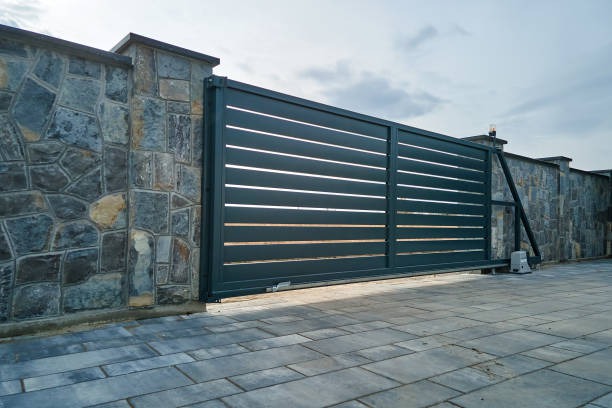Before exploring various options available, it’s crucial to pinpoint exactly what you’re looking for in a fence. Are you primarily interested in privacy or security? Perhaps you need something that keeps pets within the boundary or boosts your curb appeal. Clarifying these needs will help you make a more informed decision.
1. Styles that Speak to You
Fences are not just functional; they can significantly add to your home’s visual appeal. Do you love a classic look? Or is a modern design more your style? Once you’ve decided on the purpose, it’s easier to narrow in on styles that appeal to you and match your home’s exterior design.
For a touch of sophistication, aluminum fences make an excellent choice. They are perfect for homeowners interested in a wrought-iron look without the high cost or extensive maintenance. They are also rust-resistant and weather-proof, making them highly durable. If you’re thinking about this option, engaging aluminum fence installation services could ensure that you get the most out of your investment by assuring a professional finish.
2. Considering Your Budget
The next step involves being realistic about your budget. Different materials vary significantly in cost, not just for the material itself but also for installation and maintenance. Knowing how much you’re comfortable spending will guide you toward feasible options.
Vinyl fences are perfect for those who desire a virtually maintenance-free option. They resist weather damage, don’t chip or fade, and can be cleaned easily with a hose. Although the upfront cost might be higher than wood, the long-term savings on maintenance can make vinyl a smart investment. For those looking for alignment between durability and elegance, seeking top vinyl fence installation services might provide the best pathway to achieving that combination.
3. Factors to Consider for Durability
Weathering the Storm: Climate Considerations
Your local climate will significantly affect your fence’s longevity. Wood might not be the best option in areas with heavy rain or humidity, whereas aluminum and vinyl perform well in diverse conditions. Thinking ahead about how the weather will impact your fence helps in selecting a suitable material.
Maintenance Requirements
Different materials require different maintenance needs. Wood often requires sealing or staining every few years, while vinyl and aluminum are very low maintenance. Before making a final decision, consider the time and effort you’re willing to set aside for fence upkeep.
Wood fences are a classic staple in many neighborhoods. Known for their natural beauty and versatility, they are easily customizable in terms of height and design. However, they require regular maintenance to keep them looking fresh and to prolong their lifespan. If you’re considering hiring a wood fence installation company, take the time to check reviews and past projects to ensure quality craftsmanship.
4. Neighborhood and Property Considerations
Blending with the Neighborhood
Before deciding, take a quick tour around your neighborhood. Do most homes have wood fences, or are vinyl more popular? Aligning with neighborhood aesthetics can enhance your property value and keep community HOA (Homeowners Association) rules in check.
Property Lines and Local Regulations
Understanding the legalities associated with installing a fence is crucial. Check with your local city or county regulations to learn about setbacks and height restrictions. Confirming your property lines also avoids disputes with neighbors.
5. Eco-Friendly Options
For environmentally-conscious homeowners, choosing an eco-friendly fence material is an important consideration. There are several sustainable options available:
-
Recycled Materials: Some fences are made from recycled plastics or composites, offering a green alternative without sacrificing durability. These can provide the aesthetic benefits of wood or other traditional materials without intensive maintenance.
-
Bamboo Fencing: Bamboo is a rapidly renewable resource with a natural and exotic look, perfect for those seeking a unique style. While it may not have the longevity of materials like vinyl or aluminum, it scores high on environmental friendliness.
When considering eco-friendly options, verify manufacturers’ sustainability claims and look for certifications that ensure environmental standards.
6. Future-Proofing Your Investment
As you make your decision, think about the longevity of your investment and future-proofing your property. Here are some aspects to consider:
-
Technology Integration: In today’s smart home era, you may wish to integrate technology into your fencing system. If security or automated access is a priority, consider materials that can accommodate sensors or automated gates.
-
Resale Value: If you plan to sell your home in the future, consider how your fence choice might impact its resale value. High-quality, low-maintenance options like vinyl or well-maintained wood can appeal to potential buyers.
-
Adaptability: Choose materials and designs that allow for updates or expansions in the future. Certain materials may offer more flexibility if you wish to add decorative elements or integrate new technology.
Final Thoughts
There is no one-size-fits-all answer when it comes to selecting the perfect fence material. It’s about carefully weighing your personal preferences, climate impacts, budget constraints, and neighborhood guidelines. With this guide, you’re now equipped to make an informed decision that balances both durability and style. Remember, choose something that not only serves your practical needs but also adds beauty and value to your home.

